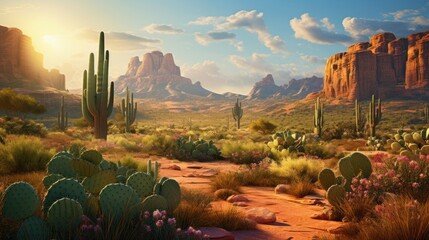The arid climate of Utah can present some unique challenges for homeowners looking to landscape their yards. With low annual rainfall, intense sun exposure, and temperature extremes, many popular landscaping plants struggle to thrive. However, with careful planning and plant selection, you can create an attractive outdoor space even in the driest conditions. Here are some tips for landscaping in Utah’s arid climate.

Select Drought-Tolerant Native Plants
When choosing plants, opt for varieties that are native to Utah and naturally adapted to the low rainfall and desert conditions. These plants will be much better equipped to handle the climate extremes. Some great options include:
- Succulents: Succulent plants like sedum, aloe, and agave store water in their leaves, making them a perfect choice for arid environments. Mix in succulents with other plants in flower beds or use them in rock gardens.
- Cacti: Hardy cactus plants need very little water to survive. Prickly pear and claret cup cacti add unique shapes and textures to both traditional garden beds or xeriscapes.
- Sagebrush: This iconic Utah native plant has silvery evergreen foliage and needs little irrigation. It works well in natural, informal garden designs.
- Utah Juniper: A native conifer tree that tolerates heat and requires minimal watering once established. Provide interest and structure year-round.
Opt for a Xeriscape Design
A xeriscape design emphasizes water conservation by using plants that thrive in arid environments. When planning a xeriscape:
- Focus on drought-tolerant plants native to Utah.
- Include hardscaping materials like paths of gravel and stone.
- Mulch generously to reduce evaporation.
- Group plants according to their water needs.
- Limit or eliminate lawns.
Xeriscaping is a great option for Utah yards, reducing irrigation needs while still providing an appealing landscape.
Read More: Renting a Home on a Yellowstone Vacation: Exploring the Untamed Beauty
Strategically Use Turf Grass
While lawns require more water, you don’t have to eliminate grass entirely. Use it strategically in play areas, pet spaces, or to tie together other landscaping. When incorporating turf grass, choose a drought-resistant variety like buffalo grass. Plant it away from desert trees and plants that demand less water. And keep the area small to limit irrigation needs. Properly irrigating a limited amount of turf grass will still conserve water compared to irrigating a full traditional lawn.

Improve Soil Health
One key to thriving plants is building healthy soil, especially in Utah’s arid climate. Spread a layer of compost over planting beds to increase the soil’s organic matter content. This helps it better retain moisture and nutrients. You can also till compost directly into the existing soil where plants will grow.
Incorporating materials like peat moss and coco coir into sandy soils improves water retention too. And add a thin layer of mulch on top of beds to reduce evaporation and keep soils from drying out as quickly. For inspiration, check out examples of Utah county landscaping to see great desert-friendly designs suited to the local climate.
Provide Supplemental Irrigation
Even drought-tolerant plants need some extra water, especially when first getting established. Install an efficient irrigation system to supplement natural rainfall. Drip irrigation or micro-spray systems apply water directly to the soil, reducing evaporation. Use smart controllers to automatically adjust watering schedules based on weather and plant needs.
Group plants with similar watering needs into zones to avoid overwatering some areas while underwatering others. Proper irrigation provides plants their required water without excessive runoff or waste.





